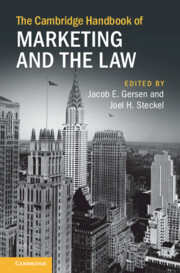Book contents
- The Cambridge Handbook of Marketing and the Law
- The Cambridge Handbook of Marketing and the Law
- Copyright page
- Dedication
- Contents
- Figures
- Tables
- Contributors
- Introduction
- Part I Understanding Consumer Behavior
- Part II Understanding Marketing Phenomena
- 5 The Persistence of False Reference Prices
- 6 Brand Value, Marketing Spending, and Brand Royalty Rates
- 7 On Puffery
- 8 Search Engine Advertising, Trademark Bidding, and Consumer Intent
- Part III Methodological Advances
- Part IV How the Law Protects
- References
6 - Brand Value, Marketing Spending, and Brand Royalty Rates
from Part II - Understanding Marketing Phenomena
Published online by Cambridge University Press: 29 June 2023
- The Cambridge Handbook of Marketing and the Law
- The Cambridge Handbook of Marketing and the Law
- Copyright page
- Dedication
- Contents
- Figures
- Tables
- Contributors
- Introduction
- Part I Understanding Consumer Behavior
- Part II Understanding Marketing Phenomena
- 5 The Persistence of False Reference Prices
- 6 Brand Value, Marketing Spending, and Brand Royalty Rates
- 7 On Puffery
- 8 Search Engine Advertising, Trademark Bidding, and Consumer Intent
- Part III Methodological Advances
- Part IV How the Law Protects
- References
Summary
According to the American Marketing Association, a brand is defined as “a name, term, design, symbol, or any other feature that identifies one seller’s goods or service as distinct from those of other sellers.”1 But to the brand owners, customers, employees, and investors, a brand is much more than just a name. A strong brand is a prized asset for many corporations. It can energize and engage the employees, create alignment around common values, and promote emotional and intellectual engagement at work. Strong brands can create positive associations in the consumer’s mind and reduce purchasing risk and search costs in buying situations. Not surprisingly, strong brands often outsell the competition, realize higher repeat purchase rates, are able to charge premium prices, and can command customer loyalty over a long time.
- Type
- Chapter
- Information
- The Cambridge Handbook of Marketing and the Law , pp. 149 - 171Publisher: Cambridge University PressPrint publication year: 2023

